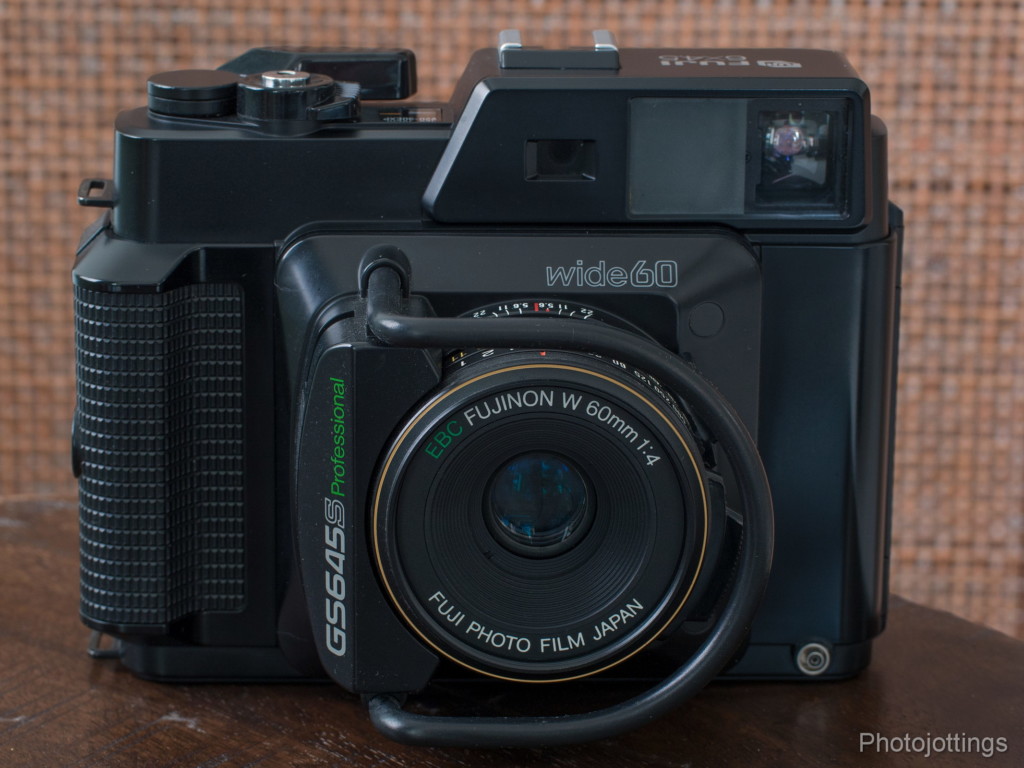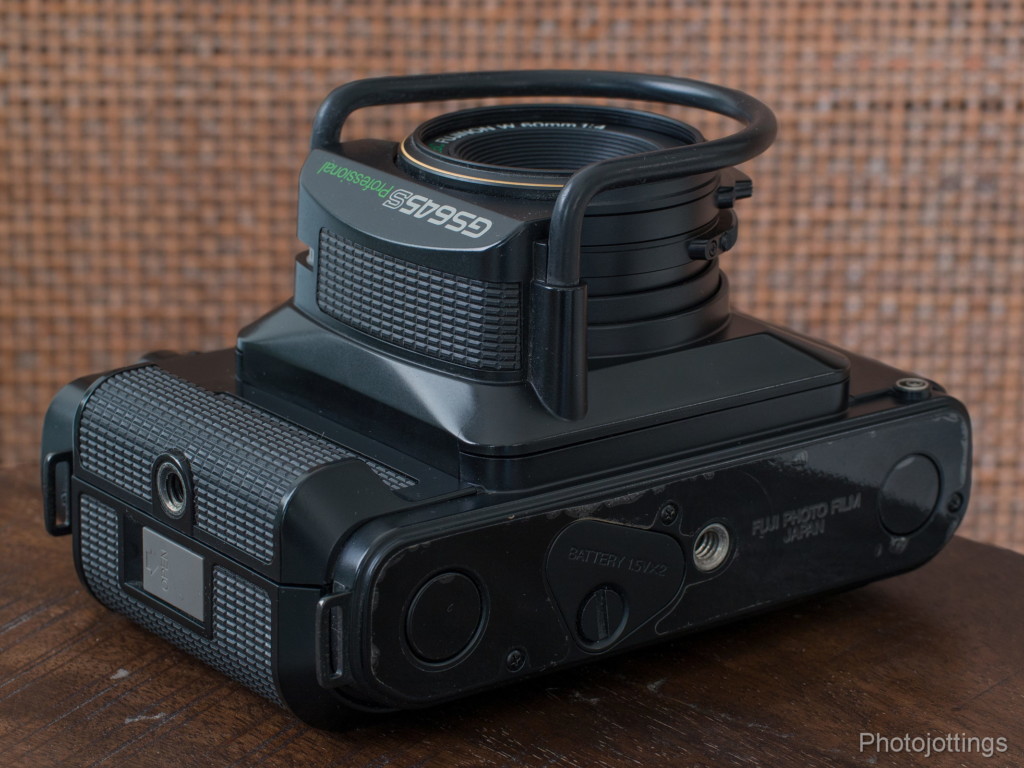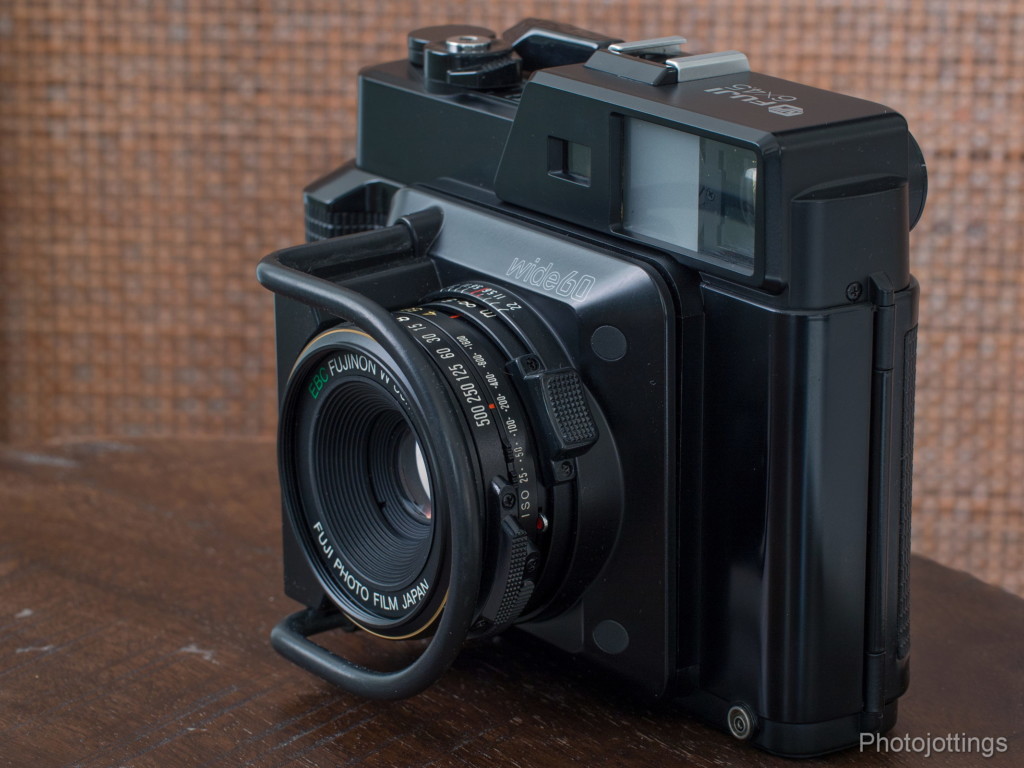The Fuji GS645S Wide 60 is a 6×4.5 medium format film camera with a fixed 60mm F/4 lens, an electronic external light metering system that runs on two button cell batteries, and a full manual mode that doesn’t require batteries, that’s what I like!! The Camera takes 120 roll film, which is still widely available today, and developing is the same as 35mm film, so your local camera shop should be able to handle all your 120 needs. The Fuji GS645S is one of three ‘GS’ models; the ‘S’ designates a 60mm lens,’ the ‘W’ as in GS645W is for a super wide 45mm F/5.6 lens, and the GS645 has a bellows and folding 75mm design. Since these cameras produce a picture similar to the aspect ratio of 135 film, we can estimate the approximate coverage area to reflect what you would see on a 35mm camera system. The 60mm lens has about the same coverage as a 38mm lens, the 45mm about 28mm, and the 75mm about 47mm. Our review camera was made in the mid 1980s.
Build quality is very good, it’s not really heavy weight-wise, but it does feel solid in handling. It weights about the same as a good 35mm camera body with 50mm F/1.4 lens.
Camera features include; a hot shoe, double exposure prevention, exposure counter with automatic reset, coupled coincidence rangefinder with automatic parallax correction, PC port (non locking type) for off camera flash, film reminder slot, film length selector (120-15 shots or 220-30 shots), and ‘Nikon’ style changeable eye piece. One of the most important features in my opinion is the lack of any power needed for use, meaning you need no batteries, it’s still functional without the exposure metering system!
The camera uses a GPD photocell through the viewfinder, with three red LED figures in the viewfinder to show you what should be the correct exposure. The three figures are + 0 – as they appear in the viewfinder. If the ‘+’ is only lit, it means over exposed by at least one stop, ‘0’ means properly exposed, and ‘-‘ is under exposed by at least one stop. Any combination of the first or last figure with the ‘0’ lit means you’re about 1/3 stop off; either over, or under. Of course you’ll need to first insert two LR44 1.5v button cell batteries, easily obtained at you local grocery store, or much cheaper here, (B&H, Amazon, eBay).
Let’s take a look at the camera specs.
Camera name. Fuji GS645S
Manufactured by; Fuji Photo Film Co. LTD, Tokyo Japan.
Made in: Japan, in the mid to late 1980s.
Original MSRP; discount companies like B&H photo listed the price in 1985 around $389.00. Current ebay prices vary from about $400-800 depending on condition and package contents.
Focusing is of course manual with a nice damped feel. You turn the finger button on the focus ring to the required distance using the coincidence (ghost image) rangefinder. Marked around the focusing ring in meters are 1, 1.2, 1.5, 2, 3, 5,and ∞. Infrared focusing mark in red, see the last product shot.
Aperture settings are; F/4, F/5.6, F/8 F/11, F/16, F/22. There are no half stop clicks, although it’s easy to use an in-between setting.
ISO settings from 25-1600 in 1/3 stop increments.
Actual picture size. 56mm x 41.5mm. Fifteen shots per standard 120 roll, but you can get 16 if you line up the arrow on the film leader about a half width short from the camera arrow.
Compared to 135 film. It would take almost 2.7 frames of 35mm film to get the same area as one 6×4.5 piece of 120 film! Capture area and depth of field is similar to 38mm, F/2.5 in 135 format.
Shutter speeds include 500, 250, 125, 60, 30, 15, 8, 4, 2, 1, T. There is no bulb mode, but you can keep the shutter open by pushing the gray button down in the slot on the right hand side (as you hold it to your face). Doing this releases the shutter, so keep a black cloth ready to cover the lens. Push the shutter button to close. The shutter speed can be at any setting when using ‘T’ mode. Also included is a 7-9 second self timer and a shutter lock button.
Lens. EBC Fujinon 60mm, F/4. Seven elements in five groups with a No. 00 interlens shutter. 5 straight shutter blades. One meter nearest focusing. Takes 49mm filters. 60° coverage diagonally. Rubber two piece lens hood originally included.
Lens characteristics. Bokeh seems smooth to just neutral depending on distance from subject to background. Both lateral and axial color fringing are negligible. Flare and ghosting control is about average for a lens of today, but great for back in the day! See pic in sample gallery below.
Film counter. Most people will probably use the ‘120’ setting as this is for standard 120 film, and produces 15 shots. I’m not sure if Japan is still selling half rolls or not, if so, use the ‘120’ setting and you’ll get 7 shots. Set the counter to ‘220’ for 30 exposures. Don’t forget to change the pressure plate when switching between 120 and 220 film.
Film pressure plate. The camera has two settings, one side for 120, flip it over for 220 film, it may be important to set it correctly as the focus will not be dead on if you have it set for the wrong type of film. My guess is 120 film is thicker than 220 as it has backing paper behind it and will wind up being slightly in front of the focus plane if there is not enough pressure to make up for the loss of paper thickness. I’ve never had any issues with this, and shot a whole roll with it in the wrong setting.
Film advance. This camera uses a single-stroke cocking feature with a 184° winding angle and 28° stand-off.
Eye-piece. You can use standard Nikon 19mm 0.75 pitch screw, F type diopter adjusting eye-pieces, Nikon FM, FE, FA .
Rangefinder and viewfinder. Double image coupled. Guide lines move as you move the focus closer or farther away. Viewfinder: 0.5x, 40mm magnification base line, 28mm effective baseline; 91% field of view at 1 meter, 90% at infinity.
Quirks. Has what’s commonly referred to as a ‘cow bar’ which is the little curved rod the goes around the lens, and is supposed to protect the very fragile lens. In case you’re wondering if this is really needed, well, all I can tell you is: I ruined my camera after a waist high drop in a padded case. As it turns out, the cow bar is attached to the plastic face plate (where the camera name is), and it doesn’t actually protect the camera much, except for minor bumps I suppose. Also, both neck strap loops are on the right side, so the camera hangs with the shutter button and hotshoe to your left instead of being level to the horizon.
My own approximate dimensions; 5.8″ (147mm) long, 4.4″ (112mm) tall, 3.5″ (90mm) deep (at cow bar). Weight is 1lb, 11oz (775g).
Product samples, pardon my dirty, (and broken) camera.








Most pictures are sized around 5000 pixels on the long end. You can eke out a little more resolution by keeping them around 6000, but they look nice and crisp slightly smaller when viewed on a computer screen.
Pool scene F/11-16, focused on the back part of pool, Kodak Portra 400. (B&H, Amazon, eBay).
Trail crossing F/11, 1/125s, Fuji Provia 100F, (B&H, Amazon, eBay). Exposure to preserve cloud detail, no graduated neutral density filter.
Blue weed near close focus, F/11, 1/125s using Fuji Pro 400h. (B&H, Amazon, eBay).
Tree last light, F/4, 1/30s, Fuji Provia 100F. Rotated for better slide show.
Sun Flare some loss of contrast but not bad for intense direct sun, F/11, 1/60s, Fuji Pro 400h. Rotated for better slide show.
F/4 test scene whole central area very sharp. not quite within depth of field along the bottom, Fuji Pro 400h.
F/5.6 test scene the lens is very sharp all over, not quite within depth of field along the bottom, Fuji Pro 400h.
F/11 test scene still very sharp, even along the bottom corners. Fuji Pro 400h.
Go here for more test shots.
Click yellow buttons for full size image.
Use notes: If you have any experience with a typical 35mm camera, like a Canon AE-1 program, Minolta 7000 or Olympus 35 SP for example, the Fuji GS645S will be quite familiar as it works in the same general way. Loading the film, advancing film with the winding lever, setting the shutter speed, ISO and aperture are all basically the same, it’s actually just a large 35mm camera. There is one notable exception though; most 6×4.5 cameras, including the GS645S captures the images in a vertical (portrait) orientation, which is the opposite of a 35mm camera. Do not concern yourself with this; It’s very easy to get used to. Another minor difference is the Fuji medium format cameras use a coincidence (ghost image) rangefinder, and viewfinder image that does not originate from the camera lens, whereas the 35mm cameras mentioned above are single lens reflex, so you get to see the actual focusing and adjustments and how they effect the picture via light through the lens, which bounces off a mirror that goes down in front of the film for viewing, and snaps back up when you press the shutter button.
The Fuji 60mm lens is very sharp wide open, even along the sides, but maxes out in resolution at F/5.6, so there isn’t much of a reason to stop down the aperture unless there are depth of field requirements. Remember, you are getting the depth of field of a 60mm lens, (not a 38mm).
The viewfinder is pretty bright, and the guide lines are easy to see. The rangefinder patch is somewhat small, but it’s adequate for fine focusing.
One thing that’s hard to get used to is the shutter button, it has a long travel before actuating, and there is no indication or ‘feel’ when it’s about to go off. I do get a shot or two on each roll that are not tack sharp, usually when the shutter speed is below 1/125s. Oh well, I may be more jittery than most?
The Fuji GS645s and 6×4.5 area of film are capable of producing very sharp digital scans (using a high quality film scanner) of around 5000, to 6000 pixels long for traditional films, which equates to around 19-27 super sharp megapixels. Specialty films like Adox CMS 20 II will most likely exceed your scanners ability to pick out the finest details, but the Nikon 9000 will produce 8000 pixel wide images that are tack sharp, which would be about 48 megapixels. Note; Adox CMS 20 II is a high contrast copy film, and needs a special developer for good pictorial use.
Here in Tucson AZ, costs average about $6 for a roll of 120 film, and about $8 to develop print film, that’s about $1 a shot which really isn’t too bad. Getting basic scans (around 2350 pixels wide) burned to a CD from you local camera shop will probably cost approximately $10 extra. It does get even more expensive if you have high resolution scans made for each shot, so save that for only your best shots! Better yet, get a decent film scanner and do it yourself.
Conclusion.
The Fuji GS645S is a great way to get started in medium format. The camera is light weight, relatively small, easy to operate, and the simple exposure meter works fairly well even with slide film; oh, and did I mention you don’t need any batteries to get full manual mode! I really like this camera, the images have much more resolution than 35mm, which allows you to crop and fit the picture in a different aspect ratio frame, like an 8×10 or 5×7 etc. Even though I dropped and ruined my first one, the lens issue won’t keep me from replacing it because it’s just so close to being a perfect walk around and vacation film camera. Two thumbs up for this little gem!
That’s it folks, thanks for visiting!















